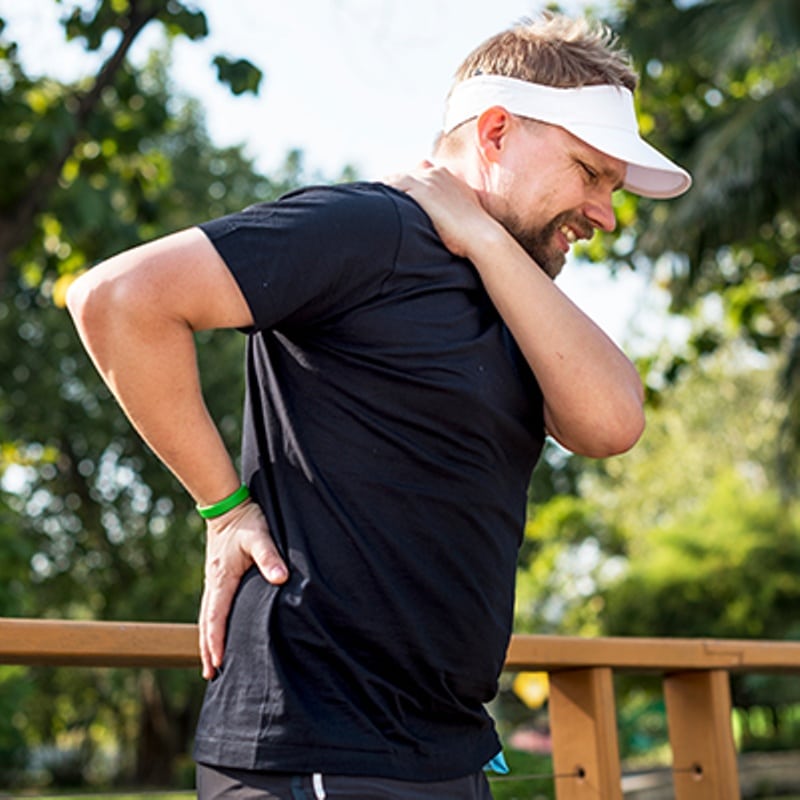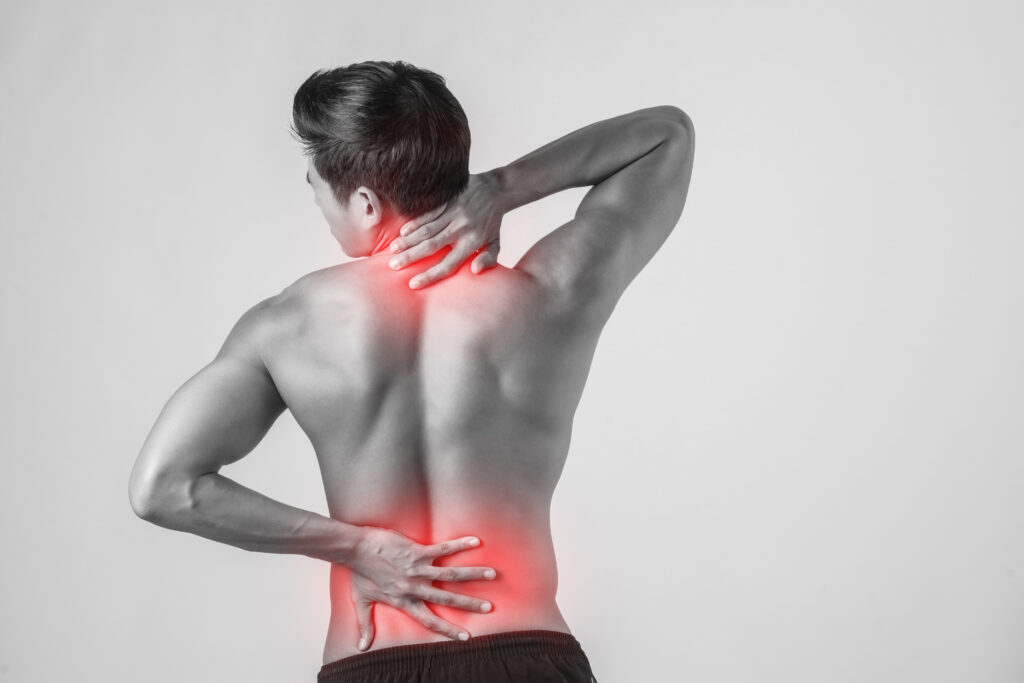If you're grappling with chronic back pain, you're not alone, and it's worth exploring non-invasive solutions that can offer relief. These methods, like physical therapy and acupuncture, target the underlying issues without the risks associated with surgery. By incorporating mindfulness practices and ergonomic adjustments, you can enhance your quality of life considerably. But what exactly do these treatments involve, and how can they fit into your daily routine? Understanding these key aspects could be the first step toward reclaiming your comfort and mobility.
Understanding Chronic Back Pain
Chronic back pain affects millions of people and can greatly impact your daily life. It's not just a fleeting discomfort; it lingers, often lasting for three months or longer. You might find yourself experiencing sharp, shooting pains or a dull ache that makes it hard to perform everyday tasks.
Understanding the nature of your chronic back pain is vital to managing it effectively. You may have various underlying causes contributing to your pain, such as poor posture, muscle strain, or even underlying conditions like arthritis or herniated discs. Identifying the root cause can help you take appropriate steps toward relief.
It's important to listen to your body and recognize when certain activities exacerbate the pain. In addition, your emotional state can influence how you perceive and cope with pain. Stress and anxiety often amplify discomfort, creating a vicious cycle. You might notice that days filled with worry can lead to increased tension in your back, making the pain feel worse.
While it's tempting to rely solely on medication for relief, understanding your pain is the first step toward finding long-term solutions. You should keep a pain journal, noting when your pain worsens and any factors that might contribute. This information can be invaluable when discussing your situation with healthcare providers.
Benefits of Non-Invasive Treatments
When you choose non-invasive treatments for chronic back pain, you're opening the door to a better quality of life without the risks associated with surgery.
These options not only help you manage pain effectively but also save you money in the long run.
Embracing these methods can lead to significant improvements in your daily activities and overall well-being.
Enhanced Quality of Life
Non-invasive treatments for back pain can considerably enhance your quality of life. By opting for methods like physical therapy, chiropractic care, or acupuncture, you can experience significant pain relief without the need for invasive procedures. These treatments focus on addressing the root cause of your discomfort, leading to long-term improvements in your daily activities.
Imagine waking up each day without the nagging pain that once held you back. You'll find it easier to engage in hobbies, spend time with loved ones, or even perform everyday tasks like lifting groceries or playing with your kids.
Non-invasive options not only alleviate pain but also boost your overall well-being. As you regain mobility and strength, your mental health may also improve. Many people report feeling more energized and optimistic when they're not battling chronic pain.
This shift can open doors to new experiences, helping you reclaim a sense of normalcy in your life. Incorporating non-invasive treatments into your routine empowers you to take control of your health.
Reduced Risk of Surgery
Choosing non-invasive treatments not only enhances your quality of life but also greatly reduces the risk of surgery. When you opt for therapies like physical therapy, chiropractic care, or acupuncture, you're actively addressing the root causes of your chronic back pain without the need for invasive procedures. This proactive approach helps you build strength, flexibility, and overall resilience in your spine.
Many people face the intimidating prospect of surgery when conventional methods fail. However, by exploring non-invasive options, you can often find significant relief and improve your condition without the complications that come with surgery. Surgical procedures carry inherent risks, including infection, prolonged recovery times, and even the possibility of needing additional surgeries down the line.
Additionally, non-invasive treatments allow you to explore various modalities tailored to your specific needs. You can adjust your treatment plan based on how your body responds, making it a more personalized and adaptive approach.
This flexibility not only empowers you but also helps you avoid the stress and uncertainty that often accompany surgical decisions. By choosing non-invasive solutions, you're investing in a safer, more holistic path to managing your chronic back pain.
Cost-Effective Treatment Options
Often, individuals find that non-invasive treatments for chronic back pain aren't only effective but also cost-efficient. You might be surprised to learn about the variety of options available that won't break the bank.
Physical therapy, for instance, often provides tailored exercises to strengthen your back without the hefty price tag associated with surgery.
Chiropractic care is another affordable alternative. Regular visits can help alleviate pain and improve mobility, which can save you money in the long run by reducing the need for medications or invasive procedures.
In addition, practicing mindfulness techniques, such as yoga or meditation, can be low-cost ways to manage pain while enhancing your overall well-being.
Over-the-counter medications, like NSAIDs, are generally accessible and can offer temporary relief without the expense of prescription drugs.
Moreover, lifestyle changes such as weight management and ergonomic adjustments at work can greatly reduce your pain and are often free or low-cost.
Physical Therapy Techniques
Physical therapy techniques play an essential role in managing chronic back pain effectively. When you engage in physical therapy, you're not just focusing on your symptoms; you're addressing the underlying issues that contribute to your pain. A skilled physical therapist will assess your condition and design a tailored program that suits your specific needs.
One common technique you might encounter is manual therapy, which involves hands-on manipulation of soft tissues and joints. This can help improve flexibility, reduce pain, and enhance your overall mobility.
Another effective approach is therapeutic exercise. Your therapist will guide you through targeted exercises aimed at strengthening your core muscles, improving posture, and increasing stability. This not only alleviates pain but also prevents future injuries.
You may also benefit from modalities such as heat and cold therapy, ultrasound, or electrical stimulation. These methods can reduce inflammation and promote healing, making it easier for you to participate in your rehabilitation program.
Additionally, your therapist might teach you techniques for proper body mechanics and ergonomics, which can help you avoid aggravating your back pain during daily activities.
As you progress through your physical therapy sessions, you'll likely notice a significant improvement in your pain levels and functional abilities. Staying consistent and committed to your therapy plan is vital for achieving long-term relief.
The Role of Acupuncture
Exploring alternative therapies can enhance your approach to managing chronic back pain, and acupuncture is one such option that many find beneficial. This ancient practice, rooted in Traditional Chinese Medicine, involves inserting thin needles into specific points on your body to stimulate energy flow, or "Qi." Many patients report significant pain relief and improved mobility after just a few sessions.
Acupuncture works by promoting the release of endorphins and other neurotransmitters, which can help alleviate pain and reduce inflammation. It's a holistic approach that not only targets the symptom but also addresses underlying factors contributing to your discomfort. You might find that acupuncture helps with stress, sleep issues, and overall well-being, creating a more thorough strategy for managing your chronic back pain.
During a typical session, a licensed acupuncture practitioner will assess your condition and tailor the treatment to your specific needs. The needles are usually painless and may be left in place for about 20 to 30 minutes. Many people feel relaxed during the treatment, allowing their bodies to respond better to the therapy.
While acupuncture can be effective, it's important to combine it with other non-invasive treatments, such as physical therapy or lifestyle modifications, for the best results. Always consult with your healthcare provider before starting any new treatment, especially if you're already undergoing other therapies.
Mindfulness and Meditation Practices
Practicing mindfulness and meditation can greatly enhance your ability to manage chronic back pain. These techniques help you focus on the present moment, allowing you to observe your thoughts and feelings without judgment. By developing this awareness, you can reduce stress and anxiety, which often exacerbate pain.
To get started, find a quiet space where you won't be disturbed. Sit comfortably, close your eyes, and take a few deep breaths. As you breathe in and out, pay attention to the sensations in your body. Notice any areas of tension or discomfort, and instead of resisting them, acknowledge their presence. This simple act of acceptance can create a shift in how you perceive pain.
You can also try guided meditations specifically designed for pain management. Many apps and online resources offer sessions that focus on relaxation and visualization techniques. These guided practices encourage you to imagine a peaceful place or visualize the pain easing away, helping you cultivate a sense of calm.
Incorporate mindfulness into your daily routine by practicing mindful walking or eating. Pay attention to each step or each bite, grounding yourself in the experience. This not only distracts you from pain but also strengthens your ability to remain present.
Ultimately, the more you practice mindfulness and meditation, the more equipped you'll feel to handle chronic back pain. With dedication, these tools can empower you to regain control over your body and enhance your overall well-being.
Innovative Ergonomic Solutions
Finding ways to manage chronic back pain often leads to exploring innovative ergonomic solutions that can make a significant difference in your daily life.
By incorporating these solutions into your routine, you can enhance comfort and support, ultimately reducing strain on your back.
Here are four effective ergonomic solutions to contemplate:
- Ergonomic Office Chair: Investing in an adjustable chair with lumbar support can help maintain proper posture while you work. Look for features like seat height adjustment and a reclining backrest.
- Standing Desk: Alternate between sitting and standing with a height-adjustable desk. This reduces prolonged pressure on your spine and encourages movement throughout the day, which can alleviate discomfort.
- Footrests: If your feet don't rest flat on the ground when sitting, use a footrest. This helps maintain a neutral spine position and prevents unnecessary strain on your lower back.
- Supportive Cushions: Use cushions or lumbar rolls in your car or at home for extra back support. These tools can promote better alignment and comfort during long periods of sitting.
Lifestyle Changes for Prevention
To prevent chronic back pain, you can start by creating an ergonomic workspace that supports your posture.
Incorporating a regular exercise routine will also strengthen your back and improve flexibility.
Together, these lifestyle changes can make a significant difference in your overall back health.
Ergonomic Workspace Setup
Creating an ergonomic workspace can greatly reduce the risk of chronic back pain. When you set up your workspace correctly, you're not just improving comfort; you're also enhancing productivity.
Here are four essential tips to evaluate for an ergonomic setup:
- Chair Height: Adjust your chair so your feet rest flat on the floor, with your knees at a 90-degree angle. This helps maintain proper posture and reduces strain on your lower back.
- Desk Height: Your desk should allow your elbows to remain at a 90-degree angle when typing. This prevents shoulder and neck tension, which can contribute to back discomfort.
- Monitor Position: Position your monitor at eye level, about an arm's length away. This keeps your head level and reduces the tendency to lean forward, alleviating stress on your spine.
- Keyboard and Mouse Placement: Keep your keyboard and mouse close enough so you can use them without stretching. This minimizes strain on your wrists and arms, promoting a more relaxed posture.
Regular Exercise Routine
An ergonomic workspace lays the foundation for a healthier back, but combining it with a regular exercise routine can greatly enhance your overall well-being and help prevent chronic back pain.
Engaging in physical activity strengthens your muscles, improves flexibility, and promotes better posture, all of which are essential for a healthy spine.
Aim for at least 150 minutes of moderate aerobic activity each week, like brisk walking or cycling. Incorporate strength training twice a week to target core muscles, which play a vital role in supporting your back.
Don't forget to include stretching exercises; they can improve flexibility and reduce tension in your muscles.
Listen to your body and choose activities you enjoy, whether it's yoga, swimming, or dancing. Consistency is key, so find a routine that fits your lifestyle and stick with it.
Complementary Therapies to Consider
Many people struggling with chronic back pain find relief through complementary therapies that support traditional treatments. These methods can enhance your overall well-being and may help reduce pain levels.
Here are four complementary therapies you should consider:
- Massage Therapy: This hands-on technique can alleviate muscle tension and improve circulation. Regular sessions might help you relax and provide temporary relief from pain.
- Acupuncture: By inserting thin needles into specific points on your body, acupuncture aims to balance energy and promote healing. Research suggests it can be effective in reducing chronic pain.
- Chiropractic Care: Chiropractors focus on spinal adjustments to improve alignment and function. Many people report reduced back pain and improved mobility after regular visits.
- Yoga and Mindfulness: Incorporating gentle yoga and mindfulness practices into your routine can help you manage stress and improve flexibility. These practices encourage body awareness, which can lead to better posture and less strain on your back.
As you explore these complementary therapies, listen to your body and consult with healthcare professionals to determine what works best for you.
Combining these therapies with traditional treatments may provide a holistic approach to managing your chronic back pain and improve your quality of life.
Conclusion
You've learned that chronic back pain doesn't have to control your life. By exploring non-invasive solutions like physical therapy, acupuncture, and mindfulness practices, you can take charge of your pain management. Incorporating ergonomic adjustments and lifestyle changes further supports your journey to improved well-being. Remember, it's all about finding what works best for you. Embrace these strategies, stay active, and empower yourself to live a fulfilling life free from the limitations of chronic pain.



